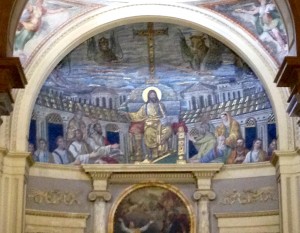There is no contest: Rome is now by far my favourite city. With its ancient monuments and plethora of excavated ruins, juxtaposed with new buildings, expensive cars and tourists on Segways, Rome is an unique place where one may simultaneously experience both the ‘modern’ and the ‘ancient’; and I am certain that this will draw me back soon (if the gelato, which is, admittedly, reason enough to go back, does not do so first).
In June 2015, thanks to a generous grant from the Classics Dept. Wardman Memorial Fund, I was able to undertake a trip to Rome as a part of my research into the effects of Christianity upon the city during the fourth century. The topic of my MA dissertation is specifically centred upon the extent to which its contemporary residents would have deemed their city to be ‘visually Christian’.
As one can imagine, since I was in the city primarily to study the early Christians, the majority of my time in Rome was spent ‘hot-footing’ around the city to various churches! Although no fourth-century churches now exist as they once did (sadly!), excavations beneath a number of currently-standing churches have uncovered their remains – it was these excavations that I was most interested in. Whilst a somewhat uncomfortable experience – going underground as a city endures 30ºC+ heat alongside sky-high humidity is not something that I would now recommend(!) – my forays were ultimately both enjoyable and fascinating as they allowed me to familiarise myself with and (in some cases) photograph the architecture and art of early Christian places of worship.
Thankfully, not all of my time was spent underground! Rather than spending my entire trip shunning the sunlight, I manage to visit several above-ground sites of significance. One of the most impressive was S. Costanza, which was originally built as a mausoleum. I also managed to visit the Forum Romanum (stopping at a few of Rome’s glorious cafes and restaurants on the way…) and take a look around: doing so certainly gave me a good idea of the appearance of the late-antique city centre.
Going to the Forum also meant that I could visit the fourth-century Basilica Nova, so that I was later able to compare its architectural features with those of the other fourth-century Christian basilicas I had visited. Further, I was also able to photograph the Arch of Constantine and familiarise myself with early fourth-century, non-Christian artwork.
My trip to Rome was ultimately incredibly helpful as it allowed me to learn a great deal about the appearance of the fourth-century city; this experience will doubtless be invaluably helpful with my MA dissertation. I would thus like to extend my gratitude to both Prof. Marzano and the entirety of the Classics faculty at the University of Reading for granting me the opportunity to travel to and conduct my research in Rome.
Christopher Pritchard
– MA (Res.), Classics



















